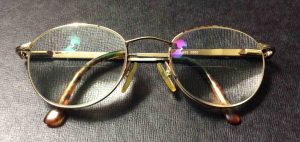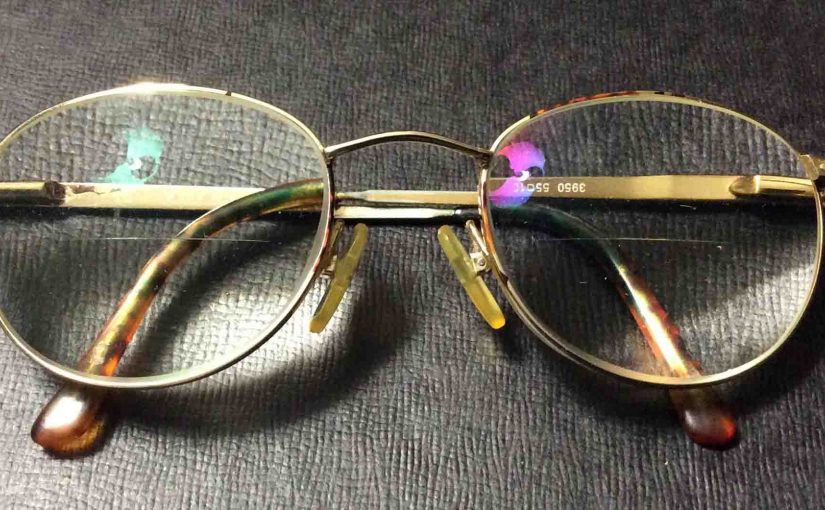We’ve worn eye glasses with anti glare coatings for three decades, and got advice from several optometrists about how best to clean them. How to clean glasses with anti glare coating is not hard once you learn how to handle them safely, which cleaners work the most gently, and which cleaning cloths scratch the lenses least.
All of these are key factors in preserving the expensive anti glare coating for as long as possible while giving a clear, glare-free view.

Why Anti Glare Glasses Work Better
Some people choose not to buy anti glare glasses due to their higher cost. But improvement in vision over non anti glare glasses is quite noticeable and worthwhile. There’s less “haze” from light reflections inside the lenses, others can see your eyes better, and this optical tech will only get better over time. So we learned how to clean ours the best way, rather than give up the technology altogether.
So given that, we’ve tried the popular dry lens cleaning cloths from Kodak and other vendors. They make these of a very thin, tissue-like paper. We also tried the costly liquid lens cleaners that work in concert with these cloths.
But our success was only moderate. Why? Because this cleaning duo left smears and streaks on the lenses, and hastened the degrading of the anti glare coating. The coating would either wear off altogether near the lens edges, or grow discolored and lighter; its anti glare properties completely fading. Its dark green purple shine would often change into a bright pink after a few months. So at nearly $100 to have the damaged coatings replaced, we soon sought better ways to preserve anti glare until the spectacles were due to be replaced anyway.
What Eye Doctors Say about How to Clean Glasses with Anti Glare Coating
We talked with numerous doctors about increasing the life of the anti glare lens coatings, and they all agreed. The best cleaner to use is a lotion-free, mild dishwashing liquid such as Great Value, Palmolive, Joy, or Ajax.
You may have to dilute the thicker liquids by mixing one part water with one part of dish soap. You want the solution thin enough that it can easily be spread with the fingers over the entire lens surfaces, both front and back.
However, avoid those dish soaps that contain lotions, oils, and lanolin for skin softening, as these can leave smears on your glasses that not even the lens cleaning cloths can remove. Also, avoid harsh chemicals and abrasive solvents such as cleansers, polishes, ammonia, or bleach based cleaners, as these can actually strip the coatings completely away over time. You want just a basic dishwashing-by-hand liquid with preferably no extra chemicals in it besides the soap.
Then, once you’ve washed and rinsed your anti glare lasses, use a microfiber cloth, specifically intended for safely cleaning anti reflective lenses. You can get these at most any place that sells glasses such as Walmart, Pearl, Lens Crafters, Sam’s Club, et al. Use this cloth, only to dry the rinsed lenses; not for actual cleaning. For actual washing, you gently rub the soaped up glasses with your fingers until you’ve completely covered all lens surfaces. Avoid excessive rubbing, as this too can prematurely wear out the AR coatings.

About Anti Glare Glasses Cleaning Cloths
Be sure to use a clean, soft, lint free lens cloth. Any oil contamination in the cloths can spread to your clean corrective lenses as you dry them, impeding their anti reflective performance, or potentially permanently degrading and damaging them. Fortunately today, these coatings have become more durable, and generally last longer under most wearing conditions. But don’t think that they’re indestructible. Anti glare coatings are still quite delicate, and can easily be scratched or destroyed if you accidentally get industrial lubricants or solvents on them. So be careful.
How to Clean Glasses with Anti Glare Coating
To sum all this up, here’s our tried-and-true procedure to clean anti glare glasses.
1. Wash your Hands First!
Make sure you remove any dirt particles, jagged nails, and loose skin from your fingertips. Use an oil-free, lotion-free hand soap.
2. Apply Water to your Anti Glare Glasses
Wet the glasses with clean water. Use filtered or softened water if you live in a hard-water area to prevent suspended particles in the water from scratching your lenses.
3. Apply a Couple Drops of Dish Soap
Then, onto each lens, place one or two drops of dishwashing liquid; the manual kind, not that for automatic dishwashers.
4. Softly Rub Anti Glare Lens Fronts with Fingers
Next, gently rub the glasses surfaces with your fingers, taking care not to press too hard. Also, be sure you have no callouses, scabs, dry skin, or other rough edges on your fingertips. These can mar the micron-thin lens coatings.
5. Rub the Back Sides of the Lenses Then
The soap you have on your fingers from the first sides should be sufficient to clean the other sides.
6. Clean Nose and Temple Pieces
Also, rub clean the nose rests and the entire frames of your glasses. You want to remove all the body oils from them, including the frames, ear pieces, nose pieces, and temple wings.
7. Rinse Soap Off
Rinse under warm, running water until the lens surfaces squeak when running your fingers across them.
8. Dry the Anti Glare Glasses
Then, use the anti reflective lens cloths mentioned above to completely dry them to a vivid shine. You’ll know that you’ve effectively cleaned the anti glare lenses if they have a deep purple or green appearance.
9. Finally, Inspect your Glasses
If the light they now reflect looks bright pink, you should try cleaning them again. We wash our lens cloths along with shirts in the washing machine once a month to ensure that they contain no granular dirt that can scratch, or oils that can smear the lenses. Antiglare lenses brightly display even the smallest of smears. So to minimize smearing, get your lenses squeaky clean (no oils left behind that can smear).
How to Clean Glasses with Anti Glare Coating: Conclusion
As with most things, an ounce of prevention is worth a pound of cure with anti glare eye glasses. So to preserve their peak performance, avoid getting them very dirty in the first place. Or at least, minimize how dirty you get them. Avoid solvents like turpentine or citrus-based cleaners. Also avoid any harsh chemicals at all, as these can quickly destroy the micro thin anti glare films on your lenses.
True, you’ll always have some body oil on glasses that are worn every day. But keep in mind. Even when you use the routine above for the safest cleaning, cleaning stresses the anti glare coatings. Too much cleaning can damage them. So, wear and store your specs such that they need the least cleaning. But when cleaning is a must, use the above routine for the least damaging yet best restoration of your delicate lenses.
Other Posts About Eye Glasses and Optics
Related Posts to How to Clean Glasses with Anti Glare Coating
References for How to Clean Glasses with Anti Glare Coating
Revision History
-
- 2019-04-12: Tweaked key word targeting, shortened post URL, added tags, and removed ad code.
- 2018-05-20: First published this post.
